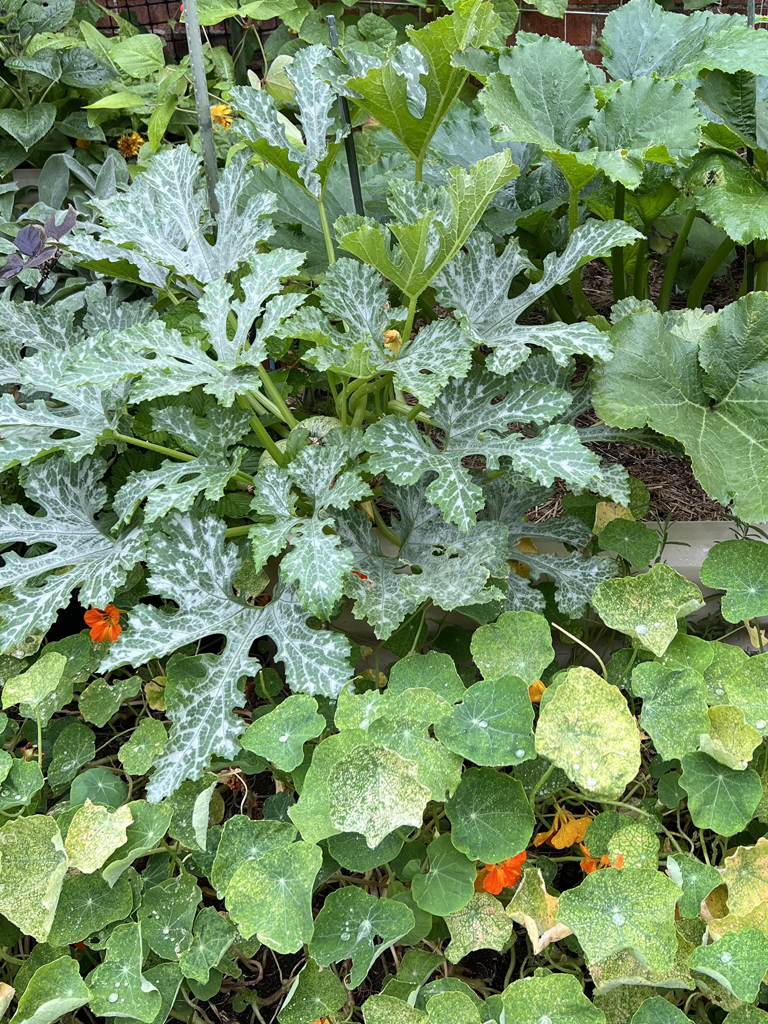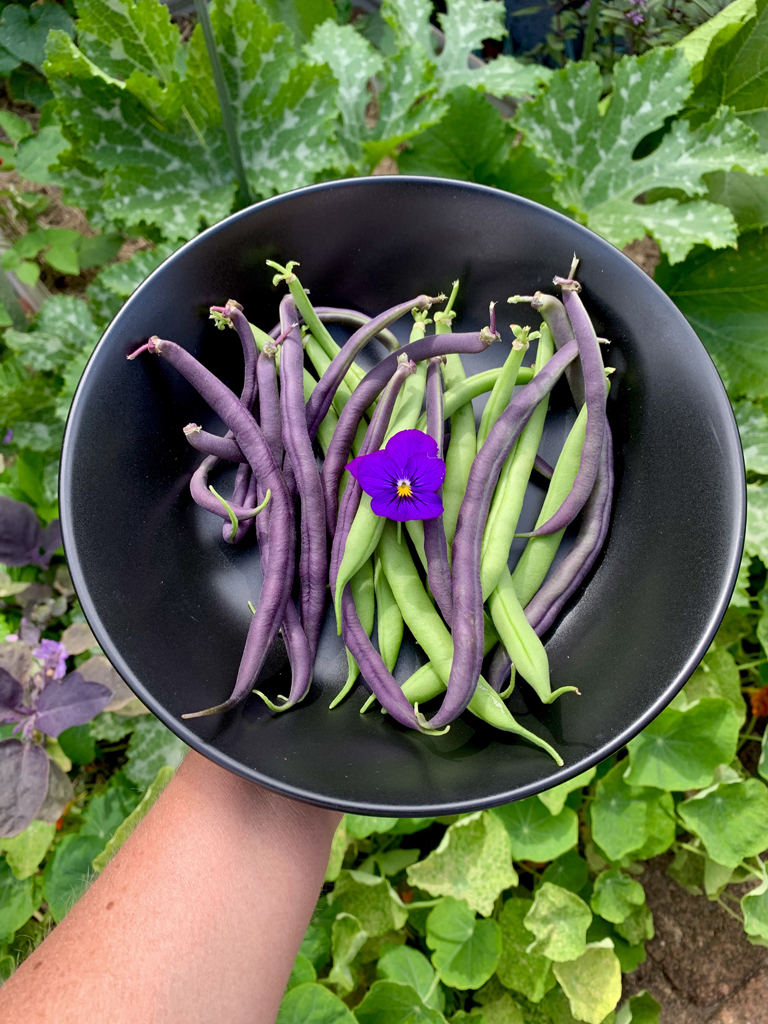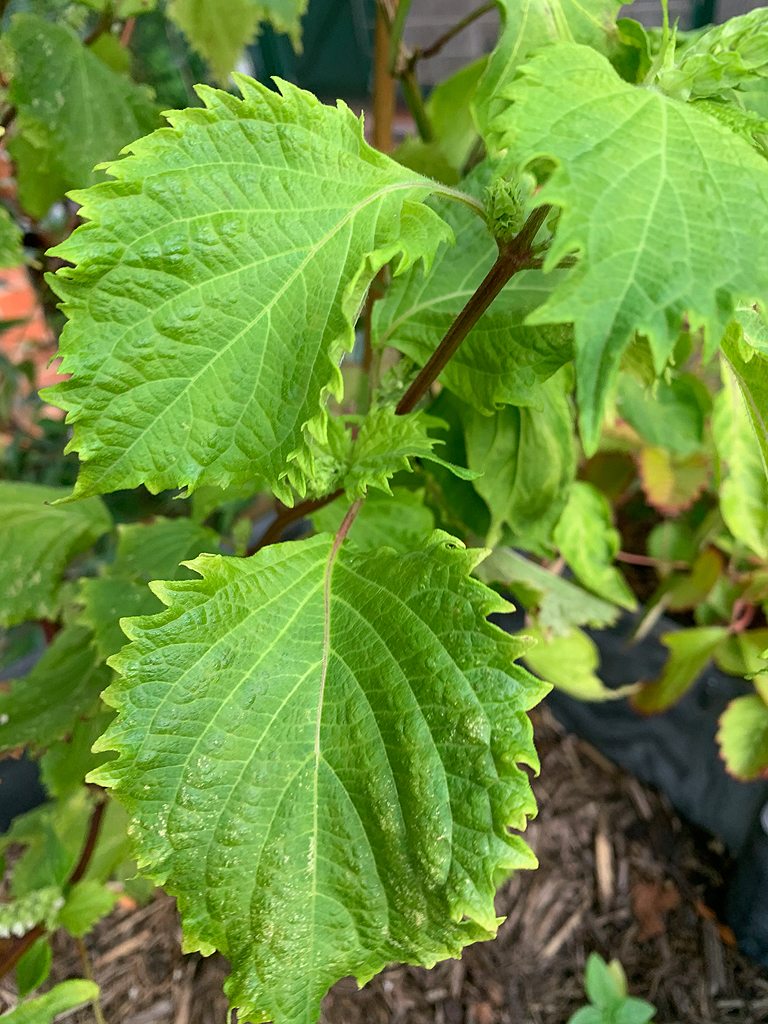Now that La Niña has been declared for the third year in a row, it’s time to revisit the spring and summer growing plans for the edible garden. In this comprehensive guide, I share the challenges and the mitigation plans I have put in place for growing summer crops.

La Niña and the Garden – Photo © The Gourmantic Garden
According to the BOM, “La Niña events increase the chances of above-average rainfall for northern and eastern Australia during spring and summer.” Cooler temperatures and wet weather have sadly become the norm of late in Sydney. What the wet conditions translate to is a combination of drainage issues, a high incidence of fungal diseases and nutrients leaching out of the soil.
Taking lessons from previous wet summers with lower than average temperatures, here are the steps I’m taking towards adapting to the changing climate.
La Niña and My Microclimate
Before I delve into the specifics, I’ll put it into context by telling you a little about my microclimate. I live on a coastal part of Sydney that doesn’t get frost in winter. My garden, which is open on three aspects (north, south and west) gets afternoon sea breezes which can turn windy and plays havoc with soft stemmed plants and flowering shrubs. The coastal location contributes to high humidity and plant diseases making powdery mildew a fact of life even during winter. Gardening on a converted paved courtyard with shallow sandy soil 5-15cm deep in parts over concrete poses another challenge for drainage during periods of heavy rains.
The last two summers with La Niña gave me the chance to observe and learn, to adapt to the wet and to revisit my growing plans on the go. This season, I have put a plan in place to mitigate some of the challenging climate conditions ahead.
La Niña & the Garden: Planning for a Wet Spring & Summer
1. Cucumber

Cucumber – Photo © The Gourmantic Garden
Cucumbers usually start well with the premise of multiple flowers that turn into fruit. Then powdery mildew takes over, along with other diseases which turn the leaves dry and crispy. Fruit production subsequently grinds to a halt and the excitement wanes when I realise I may be lucky to harvest 3 or 4 cucumbers per plant.
My plan is to sow seeds every 6-8 weeks, raise the seedlings in a medium sized pot (20cm wide) as back up plants and use them to replace disease affected cucumber plants. For this method to work, I am growing varieties such as Cucumber Spacemaster and Marketmore which are more compact, do well in pots and set fruit early.
2. Eggplant

Eggplant – Photo © The Gourmantic Garden
Eggplants are the slow growers of summer particularly when starting from seed. Early in the season, they take their sweet time to germinate and they can be even slower to grow to a sizable seedling ready for transplant particularly when the temperatures are low.
While I’m growing some of my favourite varieties from seed, my plan is twofold: buy established seedlings from a garden centre to fast track growth, and plant the healthy overwintered eggplants from the previous year.
3. Beans

Bush Beans – Photo © The Gourmantic Garden
Beans seem to do very well in my garden and continue fruiting throughout the summer. I grow mainly bush/dwarf varieties such as Provider Beans, Cherokee Beans, Royal Burgundy Beans and Rattlesnake which is a climbing variety. I had a very successful season last year by following a few simple guidelines which I documented in this article on How to Grow Bush Beans for a Continual Summer Harvest.
4. Zucchini & La Niña in the Garden

Zucchini – Photo © The Gourmantic Garden
I’ve never experienced a zucchini glut! My plants invariably succumb to powdery mildew very early in the season and production slows down significantly. In between dealing with all-male flowers, the challenges of pollination in the wet weather, powdery mildew and other pests and diseases, I usually rip out my zucchini plants early in the season.
My plan is to grow zucchinis vertically, sow seeds every 6-8 weeks to replace the diseased plants once fruiting slows down. The same applies to growing pumpkins.
5. Tomato

Tomatoes – Photo © The Gourmantic Garden
Tomatoes can be the fusspots in the summer garden, and to date I’ve lost many to pests, diseases, caterpillars, root knot nematodes and herbicide drift to name a few. The effects of La Niña in the garden will cause further havoc as long periods of heavy rain can cause the fruit to split. If your tomatoes have started to blush, it is best to harvest them and leave them to ripen indoors against a window sill.
My plan is to grow more dwarf and disease resistant varieties. Tiny Tim is a staple in my garden throughout summer and winter, and this year I’m trying a couple of new dwarf varieties as well as indeterminate tomatoes. I’m aiming for three succession plantings, the latest being towards the end of summer which would give me autumn tomatoes. Furthermore, I’m holding off transplanting tomato seedlings until they’ve grown a significant size. This way I can easily move the seedlings to a sheltered location during periods of heavy rain.
6. Corn

Corn – Photo © The Gourmantic Garden
Growing corn is a challenge in the wet and in particular when tassels form and good pollination is paramount to developing juicy kernels. There isn’t a lot to do aside from keeping an eye out on the plants and assisting in pollination. My plan is to start another round of corn seedlings in December-January and aim for a second harvest.
7. Ginger and Turmeric

Ginger – Photo © The Gourmantic Garden
I usually plant ginger and turmeric rhizomes in their permanent spot late August/early September. After losing so many last year to rot, I’m trying a different approach.
I’m planting individual rhizomes in 10cm containers which I can move to shelter before any heavy falls. Once they sprout and develop leaves, I will transplant them to their designated spot which is a couple of upcycled recycling crates against the south facing wall. The plants will get morning sun and dappled light, a location in which they have thrived in previous years despite the wet weather due to the impact of La Niña in the garden.
8. La Niña and the Garden: Chard & Perpetual Spinach

Chard – Photo © The Gourmantic Garden
Chard, silverbeet and perpetual spinach performed well last year in the wet summer and have given me ample leafy greens. However, some plants developed leaf spot after heavy rain. Once the infection takes over, usually starting with the outer leaves, it’s very difficult to get rid of. I prefer not to use any kind of spray on leafy greens no matter how organic it may be. My plan is to plant chard in several locations in the garden and start new seed in October and January.
9. Australian Native Edibles / Bush Food

Bush Food – Photo © The Gourmantic Garden
I grow over 50 different varieties of Australian native edibles and have one raised bed dedicated to bush food. Last year after prolonged periods of heavy summer rain, I lost many of them and had to start again. Fortunately, I had propagated some from cuttings, grown others from seeds or had purchased back up plants. The two that didn’t survive were native oregano and a beautiful, large native thyme bush which I replaced with new plants.
When it comes to Australian native edibles, they don’t like wet feet. When the roots become waterlogged, they can no longer take up nutrients. Even the ground sprawling Warrigal Greens can turn into a soggy, slimy wet carpet.
My plan is to start propagating for back up plants in spring, harvest Australian native edibles regularly, freeze or dehydrate excess and where possible, stake some plants such as Warrigal greens and Sea Parsley and train them to grow vertically. As for the plants growing in pots, I plan to raise these off the ground to improve drainage. I may even add perlite and horticultural sand to aid the drainage.
10. Lettuce

Lettuce – Photo © The Gourmantic Garden
Lettuce usually bolts in the heat but last season I was able to successfully grow lettuce in summer by planting it near the south facing wall which gets morning sun followed by filtered sunlight. Furthermore, it grew well in the vegepod alongside Tuscan kale and chard.
The plan is to grow heat resistant lettuce varieties and leafy types that don’t form heads, harvest frequently before it has a chance to bolt. Furthermore, I plan to use nasturtium leaves as lettuce substitute and grow a variety of heat loving greens (article to come).
11. Herbs

Japanese Shiso Perilla – Photo © The Gourmantic Garden
Hot weather herbs such as basil and shiso take their time to germinate but once established, they take off. Perennial woody herbs such as rosemary, sage, lavender and thyme are fairly resilient. During heavy rain and high humidity, the leaves can turn brown and I have lost a few herb plants that turned into a soggy brown mess. My plan is to harvest soft stemmed herbs regularly, propagate more African blue basil and grow another round of basil, shiso and soft stemmed herbs at the start of January.

Basil Seeds – Photo © The Gourmantic Garden
Last season, my globe basil had turned to seed at the time of a prolonged period of heavy rains and high humidity. A jelly-like substance developed around the seeds like blue eyes peering back. Thanks to @herbcottageau, I was informed that basil seeds are similar to chia seeds in that they form a hydrogel around them when water is added. I am told basil seeds encased in the gel are used in drinks in Asian countries and complement lychee and vanilla flavours. If it happens again, I will collect those basil seeds and try my hand at making that drink.
12. Chilli and Capsicum

Capsicum Purple Beauty – Photo © The Gourmantic Garden
Chilli and capsicum thrive in dry and hot conditions and too much water can be detrimental and can lead to the fruit splitting. I am trying a combination of overwintered chillis and peppers, buying established seedlings from a garden centre and harvesting the fruit on a regular basis.
Some General Tips on Dealing with La Niña in the Garden
- Apply a liquid fertiliser every two weeks to replenish the loss of nutrients and mineral from too much rain.
- Apply a bicarbonate soda solution spray to zucchinis, cucumbers and pumpkins (500ml water + 1/2 teaspoon bicarb soda + 2 drops of vegetable oil) every two weeks and after the rain to try and prevent the onset of powdery mildew.
- Improve air flow around plants by pruning lower leaves and stems.
- Before periods of heavy rain, follow the steps in this article on How to Prepare Your Garden for Rain in 10 Easy Steps.
Regardless of the impact of La Niña in the garden, every growing season is a challenge and for me, as a home gardener, it is about working with nature, readjusting my growing plans and learning from the experience.
If you find this article useful, please share it on your social media channels.
You may also like… El Niño and the Garden: How to Get Your Garden Ready for a Hot & Dry Summer

